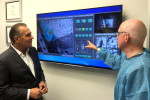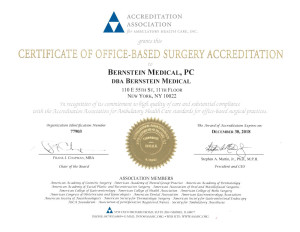 Dr. Andrew Ordon — Emmy-nominated co-host of the award-winning talk show “The Doctors” — and Dr. Robert Bernstein met at Bernstein Medical – Center for Hair Restoration in New York City on March 3, 2016 to discuss the latest advances in robotic hair transplantation.
Dr. Andrew Ordon — Emmy-nominated co-host of the award-winning talk show “The Doctors” — and Dr. Robert Bernstein met at Bernstein Medical – Center for Hair Restoration in New York City on March 3, 2016 to discuss the latest advances in robotic hair transplantation.
 Dr. Robert M. Bernstein, a pioneer of robot-assisted hair transplantation, presented results of a study on a major new advance in robotic follicular unit harvesting, a key step in the surgical procedure, at the 2016 ARTAS User Group Meeting in Dana Point, CA. He reported that the new robotic technique resulted in a clinical benefit of up to 15% more hairs per harvest attempt and 11.4% more hairs per graft than with the current iteration of the ARTAS® Robotic Hair Transplant System. The improvement in graft harvesting should result in better aesthetic outcomes for patients, and this will have wide implications around the world as robotic hair transplant procedures are booming in popularity. Dr. Bernstein presented the findings to a “who’s who” group in the new field of robotic hair restoration surgery at their annual meeting held on February 20th, 2016.
Dr. Robert M. Bernstein, a pioneer of robot-assisted hair transplantation, presented results of a study on a major new advance in robotic follicular unit harvesting, a key step in the surgical procedure, at the 2016 ARTAS User Group Meeting in Dana Point, CA. He reported that the new robotic technique resulted in a clinical benefit of up to 15% more hairs per harvest attempt and 11.4% more hairs per graft than with the current iteration of the ARTAS® Robotic Hair Transplant System. The improvement in graft harvesting should result in better aesthetic outcomes for patients, and this will have wide implications around the world as robotic hair transplant procedures are booming in popularity. Dr. Bernstein presented the findings to a “who’s who” group in the new field of robotic hair restoration surgery at their annual meeting held on February 20th, 2016.
 Gone are the days when women plucked their eyebrows to a tiny strip of hair. Thicker, more full eyebrows are “in,” reports New You magazine in “A Vision of Youthful Loveliness.” Women with eyebrows that are severely thin — from over plucking, aging, trauma, or dermatological conditions — have turned to physicians for help, and Dr. Bernstein, for one, has an answer: eyebrow transplantation.
Gone are the days when women plucked their eyebrows to a tiny strip of hair. Thicker, more full eyebrows are “in,” reports New You magazine in “A Vision of Youthful Loveliness.” Women with eyebrows that are severely thin — from over plucking, aging, trauma, or dermatological conditions — have turned to physicians for help, and Dr. Bernstein, for one, has an answer: eyebrow transplantation.
 Bernstein Medical – Center for Hair Restoration is pleased to announce that we have, once again, been certified by the Accreditation Association for Ambulatory Health Care (AAAHC). The three-year accreditation is granted to medical centers that demonstrate high standards in delivering patient care, expert record keeping, the most rigorous safety protocols, as well as a commitment to developing new ways to provide optimum service to our patients.
Bernstein Medical – Center for Hair Restoration is pleased to announce that we have, once again, been certified by the Accreditation Association for Ambulatory Health Care (AAAHC). The three-year accreditation is granted to medical centers that demonstrate high standards in delivering patient care, expert record keeping, the most rigorous safety protocols, as well as a commitment to developing new ways to provide optimum service to our patients.
A study published in the December 2015 issue of the Journal of Clinical and Aesthetic Dermatology suggests that Viviscal, an oral supplement designed for women with thinning hair, may promote hair growth. The researchers noted a 79 percent increase in healthy, terminal hairs and an almost 12 percent increase in hair diameter in female patients who took the supplement for six months. The evidence suggests that Viviscal may be a useful supplement to current hair restoration treatments, or an alternative treatment in patients not indicated for hair transplant surgery or medical treatment with finasteride.
A review of research on the efficacy of Viviscal, published in the September 2015 issue of the Journal of Drugs in Dermatology, suggests that the oral supplement may increase hair volume as well as the thickness of healthy, terminal hairs. The article presented more than two decades of research on the hair regrowth product and also included a discussion with a roundtable of dermatology and plastic surgery experts. Both the research review and roundtable discussion point to the benefits of Viviscal, however the article’s conclusions can be questioned due to the appearance of a conflict of interest between the researchers and Lifes2good, Inc., the company that produces Viviscal. Additional independent research needs to determine if Viviscal is a viable and effective hair loss treatment.
Q: I have read several articles on the internet which suggest that resistance training can accelerate male pattern baldness. Is there any truth in this? — B.F., Altherton, CA
A: Anything that raises androgen levels in your body can potentially accelerate hair loss. That said, I suggest to exercise as you normally would. As long as you don’t take drugs to enhance your workout, the effects should be minimal.
Dr. Bernstein was interviewed for an article in NYCityWoman.com that ran the gamut of available treatments for hair loss in women. Read for some select quotes on a wide range of topics related to hair loss in women and treatments for female patients with androgenetic alopecia (common genetic hair loss).
Q: How are specifications for recipient sites inputted into the ARTAS® robot? — A.F., Queens, NY
A: At the outset of the procedure, the physician sits at a computer terminal that is connected to the ARTAS Robot and enters the specifications directly into the robot’s software. Variables programmed in this manner include: the number of recipient sites, density of sites, angle that the hair will extrude from the skin, depth of recipient sites, and the minimum distance away from existing hair follicles that a site can be created.
Q: Will Robotic FUE reduce the cost per graft for FUE hair transplants? — F.K., Ditmars Boulevard, NY
A: Robotic FUE may cost slightly more per graft than a typical manual FUE procedure due to the greater expense of this new technology. At Bernstein Medical, we use the ARTAS Robotic System for all Follicular Unit Extraction (FUE) procedures.






